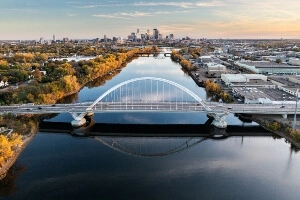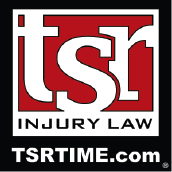Who Is at Fault for a Car Crash on a Minnesota Bridge?
Car crashes are dangerous no matter where they occur, but they can be especially hazardous when they happen on bridges. Bridges have unique risks when compared to surface roads.
Table of Contents
- Dangerous Bridges in Minnesota
- What Types of Collisions Could Happen on a Bridge?
- What Are the Most Common Causes for Car Crashes on a Bridge
- Who Could Be Liable for a Car Crash on a Bridge?
- How Could a Driver Not Involved in a Bridge Collision Be Liable for Your Damages?
- How Could I Avoid a Crash on a Bridge?
- Seeking Compensation for a Car Crash on a Minnesota Bridge? Call TSR Injury Law Today
If you were injured in a bridge crash in Minneapolis or elsewhere in Minnesota, it is important to understand your legal rights.
The Minneapolis car crash lawyers at TSR Injury Law helps crash victims throughout the complicated legal process. We have decades of experience and have obtained millions for car crash victims, with more than $1 billion recovered overall. Our firm understands the complexities of bridge crashes and state and local laws that could affect your claim compensation.
If you were involved in a crash on a bridge in Minnesota, we want to help you through your recovery. We charge no fees unless we win, and your first consultation is free of charge.
Give us a call to discuss your case: (612) TSR-TIME.
Dangerous Bridges in Minnesota
 Did you know the Federal Highway Administration has designated hundreds of bridges in the state as structurally deficient? As of April 2024, the total number of structurally deficient bridges in the state is 582.
Did you know the Federal Highway Administration has designated hundreds of bridges in the state as structurally deficient? As of April 2024, the total number of structurally deficient bridges in the state is 582.
While structural deficiencies put all drivers at risk, many bridge collisions are the result of negligent driving. You could encounter negligent driving on any bridge at any time. Here is a list of bridges where crashes commonly occur:
- Lowry Avenue Bridge
- Franklin Avenue Bridge
- Hennepin Avenue Bridge
- Cedar Avenue Bridge
- Washington Avenue Bridge
- Ford Parkway Bridge
- Broadway Avenue Bridge
- Third Avenue Bridge
- Lake Street-Marshall Bridge
- Plymouth Avenue Bridge
- 10th Avenue Bridge
What Types of Collisions Could Happen on a Bridge?
Car crashes on a bridge can happen in several ways. Common types of car crashes could include:
- Rear-end collisions: These crashes occur when one vehicle hits the back of another vehicle.
- Head-on collisions: Two vehicles traveling in opposite directions collide with each other, front-to-front.
- Multi-vehicle pileups: Crashes involving several vehicles often occur for reasons such as poor visibility or slippery conditions
- Over-height impacts: A crash involving a commercial truck or other large vehicle that is too tall and strikes an overpass.
- Ship/Barge Collision: If a ship or barge strikes a bridge, causing it to collapse, vehicles may fall into waterways or other construction.
- Debris impact: A collision that results when debris from other incidents or natural events strikes a bridge.
- Bridge Collapses Caused by Structural Deficiencies: In 2007, the I-35W Mississippi River bridge collapsed because of a design flaw. The collapse killed 13 people and injured another 145.
What Are the Most Common Causes for Car Crashes on a Bridge?
Bridges in Minnesota present unique risk factors that could increase the possibility of a crash, such as:
- Narrow Lanes: Bridges often have narrower lanes than regular roads, which can lead to sideswiping or loss of control, especially for larger vehicles.
- Slippery Conditions: Bridges are more prone to icy or wet conditions than regular roads, as they are exposed to air from all sides. This can make it harder for vehicles to maintain traction.
- Limited Visibility: Poor visibility on bridges due to fog, rain, or curves can make it difficult for drivers to see other vehicles, leading to rear-end collisions or head-on crashes.
- High Winds: Strong gusts of wind, especially on elevated or long-span bridges, can cause drivers to lose control, particularly if they are driving larger vehicles like trucks or SUVs.
- Distractions: Drivers may get distracted by the scenery or architectural features, taking their attention off the road.
- Sudden Lane Changes: Merging or lane changes can be more dangerous on bridges due to the lack of space and shoulder areas, increasing the likelihood of collisions.
- Speeding: Drivers may underestimate the risk of speeding on a bridge, especially on curves or at the bridge’s entry or exit points.
- Mechanical Failures: If a vehicle experiences brake failure or tire blowouts on a bridge, there is limited space for pulling over or avoiding other vehicles.
- Construction Zones: Ongoing bridge repairs or maintenance can create temporary lane closures or reduced speeds, which may confuse drivers.
Who Could Be Liable for Bridge Car Crash?
Responsible parties in a bridge crash might include:
Other Drivers
If your crash were caused by another driver’s negligent behavior, that individual could be liable for the damages you have suffered. Negligence is the failure to exercise reasonable care under the circumstances.
For example, if the driver behind you was distracted, by texting while driving, and failed to notice that traffic had stopped, he or she could cause a rear-end collision. The driver’s lack of attention may constitute negligence.
The Bridge Designer or Construction Company
If a design or construction flaw contributed to or directly caused the crash, the designer or construction company could be liable.
Local Government Agencies
Local governments have a responsibility to keep bridges in a safe condition. If your crash were due to a large pothole that was neglected for an extended period, the government agency responsible for maintaining the bridge could be held liable.
How Could a Driver Not Involved in a Bridge Car Crash Be Liable for Your Damages?
A driver not directly involved in a bridge car crash can still be deemed liable for a crash under certain circumstances:
Negligent Actions
If a driver does any of the following and it causes a crash, he or she may be held liable for damages:
- Stopping without signaling, causing other drivers to swerve or crash
- Changing lanes abruptly or without checking for other vehicles
- Failing to warn other drivers of a breakdown by not turning on hazard lights
- Tailgating, which could cause a chain reaction crash
Creating Hazardous Conditions
If a driver does not secure loose objects that could be ejected from their car, other drivers could crash into them. For example, other drivers may change lanes to avoid hitting the object.
Drivers may also be held responsible for a crash if they block a lane, and it leads to a crash.
How Can I Avoid a Crash on a Bridge?
Drivers can prevent a car crash on the bridge by:
- Slowing down in poor weather conditions
- Keeping a safe distance from the vehicle ahead
- Staying alert and driving defensively to anticipate other drivers
- Obeying signage and traffic signals
- Ensuring your vehicle is in good condition, especially the brakes and tires
Seeking Compensation for a Car Crash on a Minnesota Bridge? TSR Injury Law Can Help
If you were involved in a bridge car crash, you may be able to seek compensation for your damages.
At TSR Injury Law, we take pride in serving and guiding crash victims through the legal process. From the chaos of a crash to the negotiation table, we stand beside you, committed to securing the compensation you deserve. We are here for you, every step of the way, including in the courtroom if your case goes to trial. There are no fees unless we win your case.
Need legal help after a crash? Dial (612) TSR-TIME.



